Watched April 16-22, 2007
Urashima Taro no koei / The Descendant of Taro Urashima (1946)
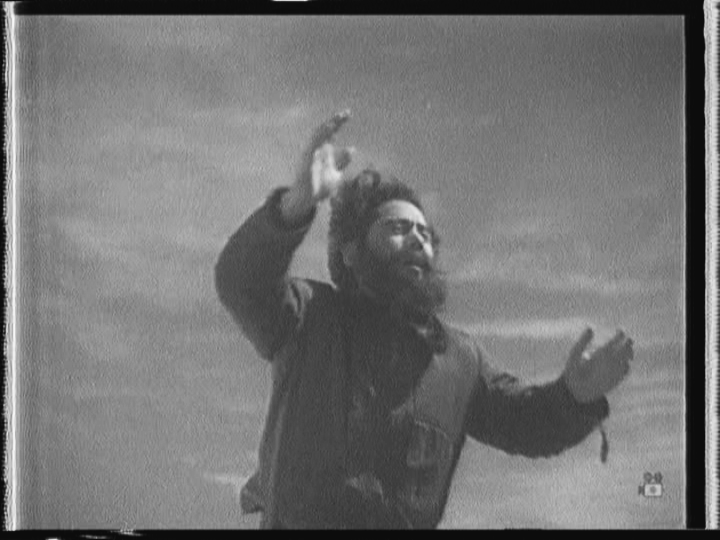 Taro Urashima is a folk tale character rather similar to Rip van Winkle. Here our hero, also named Urashima (Susumu Fujita), is a veteran returned long military service, who is confused and perplexed by the greatly changed Japan he has returned to. A shaggy , bearded fellow, he gains a bit of notoriety for a primal howl he has begun making in public places. He catches the attention of a young newspaper reporter (Hideko Takamine), who encourages him to make a more dramatic protest -- scaling the tower on top of the parliament building and bellowing his call to all Tokyo.
Taro Urashima is a folk tale character rather similar to Rip van Winkle. Here our hero, also named Urashima (Susumu Fujita), is a veteran returned long military service, who is confused and perplexed by the greatly changed Japan he has returned to. A shaggy , bearded fellow, he gains a bit of notoriety for a primal howl he has begun making in public places. He catches the attention of a young newspaper reporter (Hideko Takamine), who encourages him to make a more dramatic protest -- scaling the tower on top of the parliament building and bellowing his call to all Tokyo. 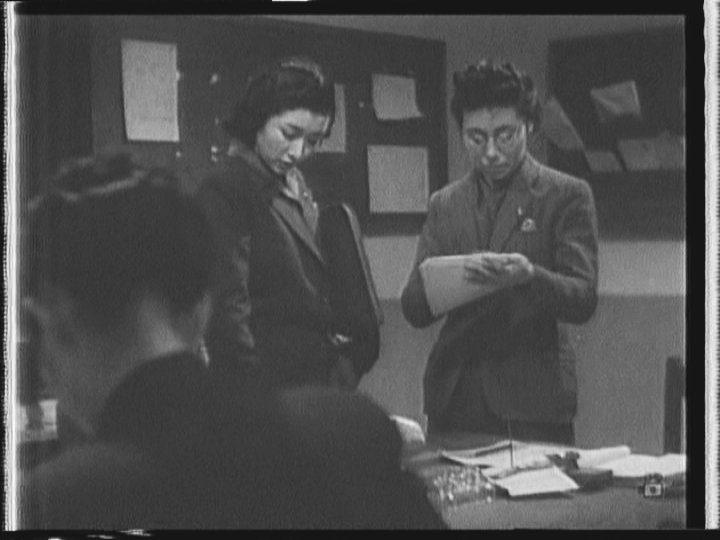 The image of the shaggy prophet on top of his parapet anticipates Bunuel's "Simon of the Desert" to a remarkable degree. Urashima holds onto his position until he collapses from fatigue. His increased notoriety brings him to the attention of a group of opportunistic politicians, who seek to exploit his popularity for their "Japanese Happiness Party". In his naivete, Urashima is increasing co-opted by the politicians (and the opportunistic daughter of their leader -- played by Hisako Yamane).
The image of the shaggy prophet on top of his parapet anticipates Bunuel's "Simon of the Desert" to a remarkable degree. Urashima holds onto his position until he collapses from fatigue. His increased notoriety brings him to the attention of a group of opportunistic politicians, who seek to exploit his popularity for their "Japanese Happiness Party". In his naivete, Urashima is increasing co-opted by the politicians (and the opportunistic daughter of their leader -- played by Hisako Yamane).
Interesting supporting performances by Haruko Sugimura (as Takamine's editor) and Nobuo Nakamura (one of the perennial crew of cronies in late Ozu -- utterly unrecognizable here as grizzled elderly friend of Urashima).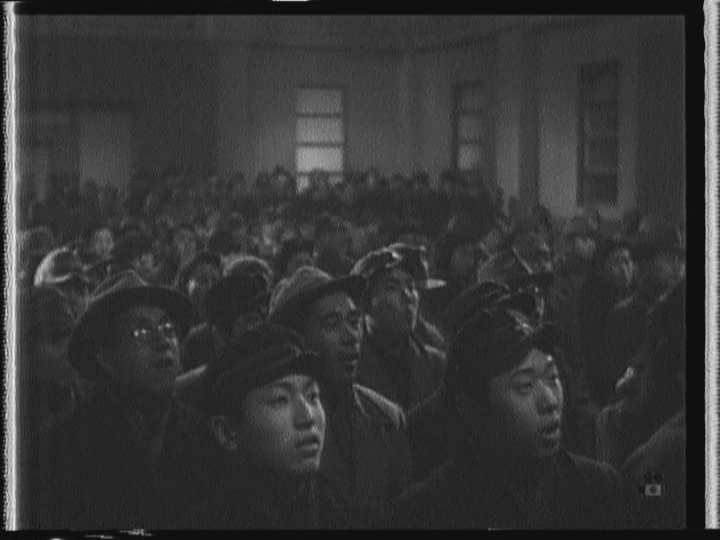 This is visually the most "Soviet" looking film I've ever seen from Naruse. Large sections have a documentary-esque look -- depicting disaffected ordinary folks in street and workplace settings. Surprisingly, Naruse even sneaks in a few shots depicting clear-cut war damage (something US military censorship did not allow). The political message here is somewhat mystifying -- not nearly so clearly supportive of Occupation-imposed values as the contemporary works of Kurosawa and Mizoguchi. While most parts of this are quite interesting, there are a few duller spots. Not a major work of Naruse film art, but an intriguing sidelight, both as to Naruse's career and as to Japan in the immediate aftermath of the war.
This is visually the most "Soviet" looking film I've ever seen from Naruse. Large sections have a documentary-esque look -- depicting disaffected ordinary folks in street and workplace settings. Surprisingly, Naruse even sneaks in a few shots depicting clear-cut war damage (something US military censorship did not allow). The political message here is somewhat mystifying -- not nearly so clearly supportive of Occupation-imposed values as the contemporary works of Kurosawa and Mizoguchi. While most parts of this are quite interesting, there are a few duller spots. Not a major work of Naruse film art, but an intriguing sidelight, both as to Naruse's career and as to Japan in the immediate aftermath of the war.
Tsuma no kokoro / A Wife's Heart (Mikio Naruse, 1956)
 Hideko Takamine and Keiju Kobayashi are as happily married as a childless couple in 1950s Japan can be -- except for the fact that Kobayashi must run the family store under the always watchful eyes of his rather intimidating mother (Eiko Miyoshi -- the scary neighbor granny in Ozu's "Good Morning"). Takamine has been saving up her money so that she can open her own cafe -- and has taken a job to learn the business -- in a diner run by Sadako Sawamura and Daisuke Kato.
Hideko Takamine and Keiju Kobayashi are as happily married as a childless couple in 1950s Japan can be -- except for the fact that Kobayashi must run the family store under the always watchful eyes of his rather intimidating mother (Eiko Miyoshi -- the scary neighbor granny in Ozu's "Good Morning"). Takamine has been saving up her money so that she can open her own cafe -- and has taken a job to learn the business -- in a diner run by Sadako Sawamura and Daisuke Kato. 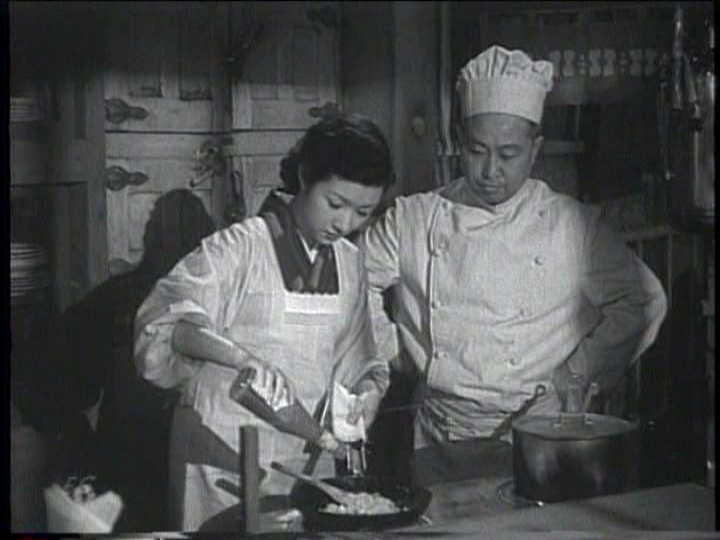 Unfortunately, the matriarch has other plans for all family cash -- funding the marriage of her daughter. Thwarted, Takamine seeks a loan from the banker brother (Toshiro Mifune) of her best friend (Yoko Sugi). Although Takamine gets her loan, it turns out her husband's elder brother (Chiaki Minoru) is a having business problems -- and again the matriarch applies pressure to get all available cash out of the pockets of our hero and heroine. As Kobayashi begins to lose it (fleeing to a geisha house to escape the pressure at home), Takanine grows increasingly attracted to Mifune.
Unfortunately, the matriarch has other plans for all family cash -- funding the marriage of her daughter. Thwarted, Takamine seeks a loan from the banker brother (Toshiro Mifune) of her best friend (Yoko Sugi). Although Takamine gets her loan, it turns out her husband's elder brother (Chiaki Minoru) is a having business problems -- and again the matriarch applies pressure to get all available cash out of the pockets of our hero and heroine. As Kobayashi begins to lose it (fleeing to a geisha house to escape the pressure at home), Takanine grows increasingly attracted to Mifune.
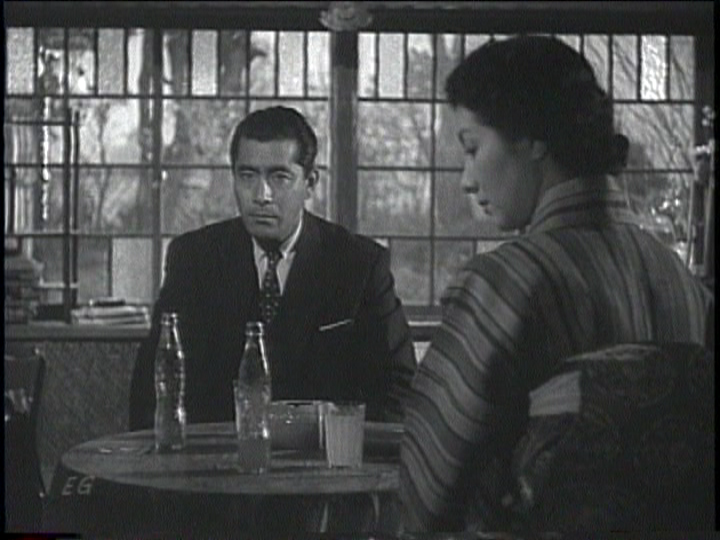 A visually lovely film -- especially in a sequence involving a stroll in a mountainside park by Mifune and Takanine -- and another in which they waiting out a sudden rainstorm in a cafe. Wonderful performances (by the whole large cast). While much of the story IS communicated visually -- the story line is sufficiently complex that (full) understanding of the dialog is close to imperative. I will need to watch again -- and try to decipher more. This seems to have been well-received when shown in the recent retrospective (alas, this is a film I didn't get to see screened then -- with subtitles).
A visually lovely film -- especially in a sequence involving a stroll in a mountainside park by Mifune and Takanine -- and another in which they waiting out a sudden rainstorm in a cafe. Wonderful performances (by the whole large cast). While much of the story IS communicated visually -- the story line is sufficiently complex that (full) understanding of the dialog is close to imperative. I will need to watch again -- and try to decipher more. This seems to have been well-received when shown in the recent retrospective (alas, this is a film I didn't get to see screened then -- with subtitles).
More screenshots:
http://i9.photobucket.com/albums/a59/mkerpan/kokoro/kokoro04.png
http://i9.photobucket.com/albums/a59/mkerpan/kokoro/kokoro07.png
http://i9.photobucket.com/albums/a59/mkerpan/kokoro/kokoro08.png
http://i9.photobucket.com/albums/a59/mkerpan/kokoro/kokoro09.png
http://i9.photobucket.com/albums/a59/mkerpan/kokoro/kokoro10.png
http://i9.photobucket.com/albums/a59/mkerpan/kokoro/kokoro13.png
http://i9.photobucket.com/albums/a59/mkerpan/kokoro/kokoro14.png
http://i9.photobucket.com/albums/a59/mkerpan/kokoro/kokoro16.png
Kuroi junin no onna / Ten Dark Women (Kon Ichikawa, 1961)
 A philandering producer has pushed ten of his woman (including his wife) too far, and the women decide to do something about it. All ten conspire to knock the producer off -- meanwhile. each schemes individually to rescue him, so long as she can come up with a way to keep him all to herself.
A philandering producer has pushed ten of his woman (including his wife) too far, and the women decide to do something about it. All ten conspire to knock the producer off -- meanwhile. each schemes individually to rescue him, so long as she can come up with a way to keep him all to herself.
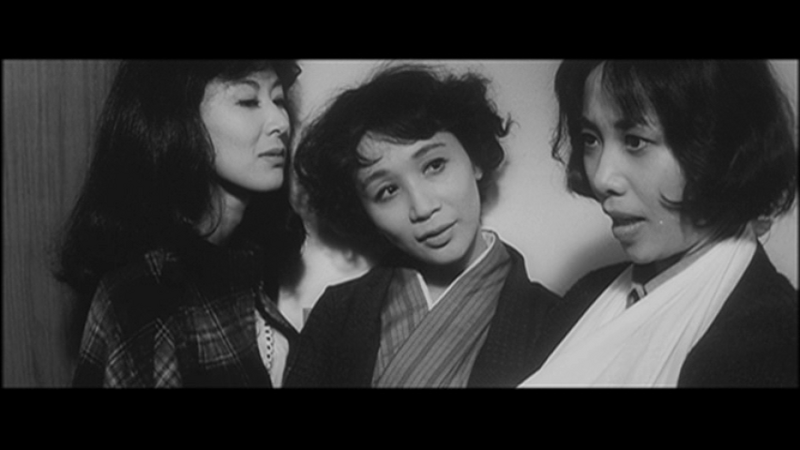 The Japanese DVD looks pretty good -but it has no subtitles. Though visually interesting, this film also is dependent on its dialog. Criterion (or Masters of Cinema) really needs to get moving on releasing this impressive, ferociously dark comedy in the West.
The Japanese DVD looks pretty good -but it has no subtitles. Though visually interesting, this film also is dependent on its dialog. Criterion (or Masters of Cinema) really needs to get moving on releasing this impressive, ferociously dark comedy in the West.
More screen shots:
http://i9.photobucket.com/albums/a59/mkerpan/10_dark/10bw02.png
http://i9.photobucket.com/albums/a59/mkerpan/10_dark/10bw03.png
http://i9.photobucket.com/albums/a59/mkerpan/10_dark/10bw05.png
http://i9.photobucket.com/albums/a59/mkerpan/10_dark/10bw06.png
http://i9.photobucket.com/albums/a59/mkerpan/10_dark/10bw07.png
http://i9.photobucket.com/albums/a59/mkerpan/10_dark/10bw08.png
http://i9.photobucket.com/albums/a59/mkerpan/10_dark/10bw09.png
http://i9.photobucket.com/albums/a59/mkerpan/10_dark/10bw10.png
Onna no rekishi / A Woman's Story (Mikio Naruse, 1963)
 Yet another Naruse family drama starring Hideko Takamine. Here Takamine is a war widow, living with her grown son (Tsutomo Yamikazi) and mother-in-law (Natsulo Kahara) -- and supporting the family by running a beauty parlor. Hardworking Takamine is reasonably content -- until her son announces he wants to marry a dancing girl from a cabaret (Yuriko Hoshi) -- at which point, familial strife ensues. A
Yet another Naruse family drama starring Hideko Takamine. Here Takamine is a war widow, living with her grown son (Tsutomo Yamikazi) and mother-in-law (Natsulo Kahara) -- and supporting the family by running a beauty parlor. Hardworking Takamine is reasonably content -- until her son announces he wants to marry a dancing girl from a cabaret (Yuriko Hoshi) -- at which point, familial strife ensues. A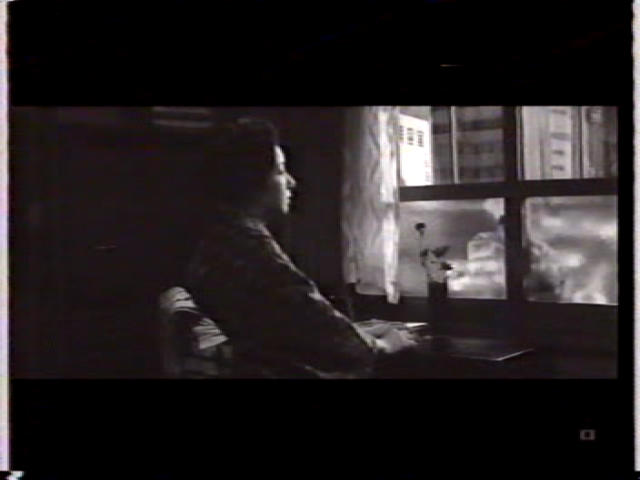 long the way, the film dips into the past, as Takamine recalls her courtship, early days of marriage, the war years (etc.). By and large a very interesting, black and white Tohoscope format film. Other than being a bit more diffuse than the average Naruse film, the only real flaw is a score that occasionally includes cheesy synthesized-sounding music.
long the way, the film dips into the past, as Takamine recalls her courtship, early days of marriage, the war years (etc.). By and large a very interesting, black and white Tohoscope format film. Other than being a bit more diffuse than the average Naruse film, the only real flaw is a score that occasionally includes cheesy synthesized-sounding music.
More pictures:
http://i9.photobucket.com/albums/a59/mkerpan/rekishi/rekishi01.png
http://i9.photobucket.com/albums/a59/mkerpan/rekishi/rekishi02.png
http://i9.photobucket.com/albums/a59/mkerpan/rekishi/rekishi03.png
http://i9.photobucket.com/albums/a59/mkerpan/rekishi/rekishi04.png
http://i9.photobucket.com/albums/a59/mkerpan/rekishi/rekishi05.png
http://i9.photobucket.com/albums/a59/mkerpan/rekishi/rekishi06.png
http://i9.photobucket.com/albums/a59/mkerpan/rekishi/rekishi07.png
http://i9.photobucket.com/albums/a59/mkerpan/rekishi/rekishi08.png
http://i9.photobucket.com/albums/a59/mkerpan/rekishi/rekishi09.png
http://i9.photobucket.com/albums/a59/mkerpan/rekishi/rekishi10.png
http://i9.photobucket.com/albums/a59/mkerpan/rekishi/rekishi11.png
http://i9.photobucket.com/albums/a59/mkerpan/rekishi/rekishi12.png
http://i9.photobucket.com/albums/a59/mkerpan/rekishi/rekishi13.png
http://i9.photobucket.com/albums/a59/mkerpan/rekishi/rekishi15.png
http://i9.photobucket.com/albums/a59/mkerpan/rekishi/rekishi17.png
http://i9.photobucket.com/albums/a59/mkerpan/rekishi/rekishi18.png
 Taro Urashima is a folk tale character rather similar to Rip van Winkle. Here our hero, also named Urashima (Susumu Fujita), is a veteran returned long military service, who is confused and perplexed by the greatly changed Japan he has returned to. A shaggy , bearded fellow, he gains a bit of notoriety for a primal howl he has begun making in public places. He catches the attention of a young newspaper reporter (Hideko Takamine), who encourages him to make a more dramatic protest -- scaling the tower on top of the parliament building and bellowing his call to all Tokyo.
Taro Urashima is a folk tale character rather similar to Rip van Winkle. Here our hero, also named Urashima (Susumu Fujita), is a veteran returned long military service, who is confused and perplexed by the greatly changed Japan he has returned to. A shaggy , bearded fellow, he gains a bit of notoriety for a primal howl he has begun making in public places. He catches the attention of a young newspaper reporter (Hideko Takamine), who encourages him to make a more dramatic protest -- scaling the tower on top of the parliament building and bellowing his call to all Tokyo.  The image of the shaggy prophet on top of his parapet anticipates Bunuel's "Simon of the Desert" to a remarkable degree. Urashima holds onto his position until he collapses from fatigue. His increased notoriety brings him to the attention of a group of opportunistic politicians, who seek to exploit his popularity for their "Japanese Happiness Party". In his naivete, Urashima is increasing co-opted by the politicians (and the opportunistic daughter of their leader -- played by Hisako Yamane).
The image of the shaggy prophet on top of his parapet anticipates Bunuel's "Simon of the Desert" to a remarkable degree. Urashima holds onto his position until he collapses from fatigue. His increased notoriety brings him to the attention of a group of opportunistic politicians, who seek to exploit his popularity for their "Japanese Happiness Party". In his naivete, Urashima is increasing co-opted by the politicians (and the opportunistic daughter of their leader -- played by Hisako Yamane).Interesting supporting performances by Haruko Sugimura (as Takamine's editor) and Nobuo Nakamura (one of the perennial crew of cronies in late Ozu -- utterly unrecognizable here as grizzled elderly friend of Urashima).
 This is visually the most "Soviet" looking film I've ever seen from Naruse. Large sections have a documentary-esque look -- depicting disaffected ordinary folks in street and workplace settings. Surprisingly, Naruse even sneaks in a few shots depicting clear-cut war damage (something US military censorship did not allow). The political message here is somewhat mystifying -- not nearly so clearly supportive of Occupation-imposed values as the contemporary works of Kurosawa and Mizoguchi. While most parts of this are quite interesting, there are a few duller spots. Not a major work of Naruse film art, but an intriguing sidelight, both as to Naruse's career and as to Japan in the immediate aftermath of the war.
This is visually the most "Soviet" looking film I've ever seen from Naruse. Large sections have a documentary-esque look -- depicting disaffected ordinary folks in street and workplace settings. Surprisingly, Naruse even sneaks in a few shots depicting clear-cut war damage (something US military censorship did not allow). The political message here is somewhat mystifying -- not nearly so clearly supportive of Occupation-imposed values as the contemporary works of Kurosawa and Mizoguchi. While most parts of this are quite interesting, there are a few duller spots. Not a major work of Naruse film art, but an intriguing sidelight, both as to Naruse's career and as to Japan in the immediate aftermath of the war. Tsuma no kokoro / A Wife's Heart (Mikio Naruse, 1956)
 Hideko Takamine and Keiju Kobayashi are as happily married as a childless couple in 1950s Japan can be -- except for the fact that Kobayashi must run the family store under the always watchful eyes of his rather intimidating mother (Eiko Miyoshi -- the scary neighbor granny in Ozu's "Good Morning"). Takamine has been saving up her money so that she can open her own cafe -- and has taken a job to learn the business -- in a diner run by Sadako Sawamura and Daisuke Kato.
Hideko Takamine and Keiju Kobayashi are as happily married as a childless couple in 1950s Japan can be -- except for the fact that Kobayashi must run the family store under the always watchful eyes of his rather intimidating mother (Eiko Miyoshi -- the scary neighbor granny in Ozu's "Good Morning"). Takamine has been saving up her money so that she can open her own cafe -- and has taken a job to learn the business -- in a diner run by Sadako Sawamura and Daisuke Kato.  Unfortunately, the matriarch has other plans for all family cash -- funding the marriage of her daughter. Thwarted, Takamine seeks a loan from the banker brother (Toshiro Mifune) of her best friend (Yoko Sugi). Although Takamine gets her loan, it turns out her husband's elder brother (Chiaki Minoru) is a having business problems -- and again the matriarch applies pressure to get all available cash out of the pockets of our hero and heroine. As Kobayashi begins to lose it (fleeing to a geisha house to escape the pressure at home), Takanine grows increasingly attracted to Mifune.
Unfortunately, the matriarch has other plans for all family cash -- funding the marriage of her daughter. Thwarted, Takamine seeks a loan from the banker brother (Toshiro Mifune) of her best friend (Yoko Sugi). Although Takamine gets her loan, it turns out her husband's elder brother (Chiaki Minoru) is a having business problems -- and again the matriarch applies pressure to get all available cash out of the pockets of our hero and heroine. As Kobayashi begins to lose it (fleeing to a geisha house to escape the pressure at home), Takanine grows increasingly attracted to Mifune.  A visually lovely film -- especially in a sequence involving a stroll in a mountainside park by Mifune and Takanine -- and another in which they waiting out a sudden rainstorm in a cafe. Wonderful performances (by the whole large cast). While much of the story IS communicated visually -- the story line is sufficiently complex that (full) understanding of the dialog is close to imperative. I will need to watch again -- and try to decipher more. This seems to have been well-received when shown in the recent retrospective (alas, this is a film I didn't get to see screened then -- with subtitles).
A visually lovely film -- especially in a sequence involving a stroll in a mountainside park by Mifune and Takanine -- and another in which they waiting out a sudden rainstorm in a cafe. Wonderful performances (by the whole large cast). While much of the story IS communicated visually -- the story line is sufficiently complex that (full) understanding of the dialog is close to imperative. I will need to watch again -- and try to decipher more. This seems to have been well-received when shown in the recent retrospective (alas, this is a film I didn't get to see screened then -- with subtitles).More screenshots:
http://i9.photobucket.com/albums/a59/mkerpan/kokoro/kokoro04.png
http://i9.photobucket.com/albums/a59/mkerpan/kokoro/kokoro07.png
http://i9.photobucket.com/albums/a59/mkerpan/kokoro/kokoro08.png
http://i9.photobucket.com/albums/a59/mkerpan/kokoro/kokoro09.png
http://i9.photobucket.com/albums/a59/mkerpan/kokoro/kokoro10.png
http://i9.photobucket.com/albums/a59/mkerpan/kokoro/kokoro13.png
http://i9.photobucket.com/albums/a59/mkerpan/kokoro/kokoro14.png
http://i9.photobucket.com/albums/a59/mkerpan/kokoro/kokoro16.png
Kuroi junin no onna / Ten Dark Women (Kon Ichikawa, 1961)
 A philandering producer has pushed ten of his woman (including his wife) too far, and the women decide to do something about it. All ten conspire to knock the producer off -- meanwhile. each schemes individually to rescue him, so long as she can come up with a way to keep him all to herself.
A philandering producer has pushed ten of his woman (including his wife) too far, and the women decide to do something about it. All ten conspire to knock the producer off -- meanwhile. each schemes individually to rescue him, so long as she can come up with a way to keep him all to herself. The Japanese DVD looks pretty good -but it has no subtitles. Though visually interesting, this film also is dependent on its dialog. Criterion (or Masters of Cinema) really needs to get moving on releasing this impressive, ferociously dark comedy in the West.
The Japanese DVD looks pretty good -but it has no subtitles. Though visually interesting, this film also is dependent on its dialog. Criterion (or Masters of Cinema) really needs to get moving on releasing this impressive, ferociously dark comedy in the West. More screen shots:
http://i9.photobucket.com/albums/a59/mkerpan/10_dark/10bw02.png
http://i9.photobucket.com/albums/a59/mkerpan/10_dark/10bw03.png
http://i9.photobucket.com/albums/a59/mkerpan/10_dark/10bw05.png
http://i9.photobucket.com/albums/a59/mkerpan/10_dark/10bw06.png
http://i9.photobucket.com/albums/a59/mkerpan/10_dark/10bw07.png
http://i9.photobucket.com/albums/a59/mkerpan/10_dark/10bw08.png
http://i9.photobucket.com/albums/a59/mkerpan/10_dark/10bw09.png
http://i9.photobucket.com/albums/a59/mkerpan/10_dark/10bw10.png
Onna no rekishi / A Woman's Story (Mikio Naruse, 1963)
 Yet another Naruse family drama starring Hideko Takamine. Here Takamine is a war widow, living with her grown son (Tsutomo Yamikazi) and mother-in-law (Natsulo Kahara) -- and supporting the family by running a beauty parlor. Hardworking Takamine is reasonably content -- until her son announces he wants to marry a dancing girl from a cabaret (Yuriko Hoshi) -- at which point, familial strife ensues. A
Yet another Naruse family drama starring Hideko Takamine. Here Takamine is a war widow, living with her grown son (Tsutomo Yamikazi) and mother-in-law (Natsulo Kahara) -- and supporting the family by running a beauty parlor. Hardworking Takamine is reasonably content -- until her son announces he wants to marry a dancing girl from a cabaret (Yuriko Hoshi) -- at which point, familial strife ensues. A long the way, the film dips into the past, as Takamine recalls her courtship, early days of marriage, the war years (etc.). By and large a very interesting, black and white Tohoscope format film. Other than being a bit more diffuse than the average Naruse film, the only real flaw is a score that occasionally includes cheesy synthesized-sounding music.
long the way, the film dips into the past, as Takamine recalls her courtship, early days of marriage, the war years (etc.). By and large a very interesting, black and white Tohoscope format film. Other than being a bit more diffuse than the average Naruse film, the only real flaw is a score that occasionally includes cheesy synthesized-sounding music.More pictures:
http://i9.photobucket.com/albums/a59/mkerpan/rekishi/rekishi01.png
http://i9.photobucket.com/albums/a59/mkerpan/rekishi/rekishi02.png
http://i9.photobucket.com/albums/a59/mkerpan/rekishi/rekishi03.png
http://i9.photobucket.com/albums/a59/mkerpan/rekishi/rekishi04.png
http://i9.photobucket.com/albums/a59/mkerpan/rekishi/rekishi05.png
http://i9.photobucket.com/albums/a59/mkerpan/rekishi/rekishi06.png
http://i9.photobucket.com/albums/a59/mkerpan/rekishi/rekishi07.png
http://i9.photobucket.com/albums/a59/mkerpan/rekishi/rekishi08.png
http://i9.photobucket.com/albums/a59/mkerpan/rekishi/rekishi09.png
http://i9.photobucket.com/albums/a59/mkerpan/rekishi/rekishi10.png
http://i9.photobucket.com/albums/a59/mkerpan/rekishi/rekishi11.png
http://i9.photobucket.com/albums/a59/mkerpan/rekishi/rekishi12.png
http://i9.photobucket.com/albums/a59/mkerpan/rekishi/rekishi13.png
http://i9.photobucket.com/albums/a59/mkerpan/rekishi/rekishi15.png
http://i9.photobucket.com/albums/a59/mkerpan/rekishi/rekishi17.png
http://i9.photobucket.com/albums/a59/mkerpan/rekishi/rekishi18.png
Comments
As always, thanks for the reviews and pictures....
I don't know how long it would have taken, after the war, for Japanese film makers to make up for lost time.
It's been too long a time since I've seen "Meet John Doe" for me to remember much about visual composition.